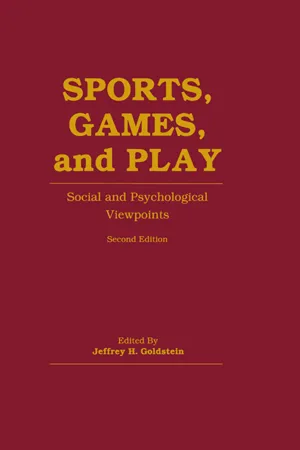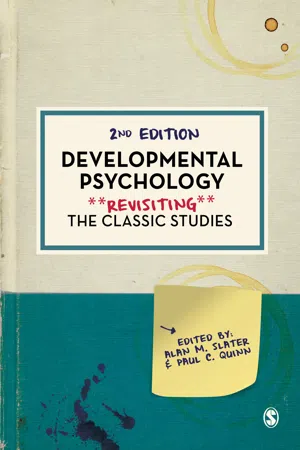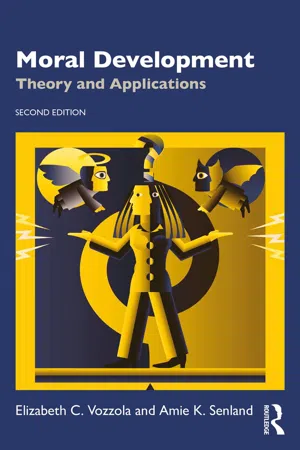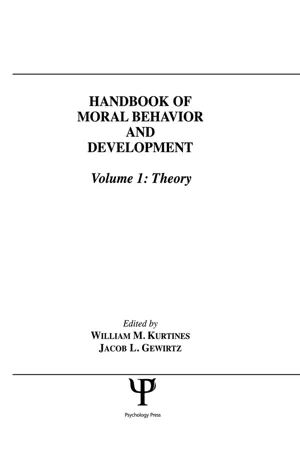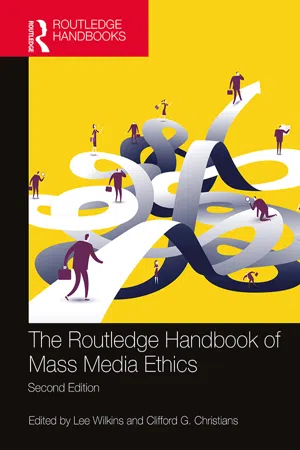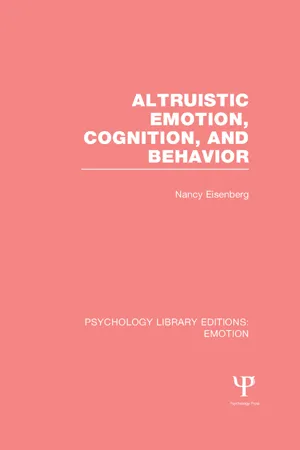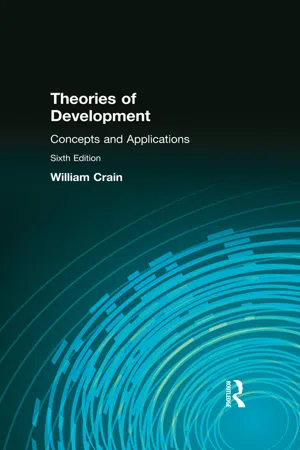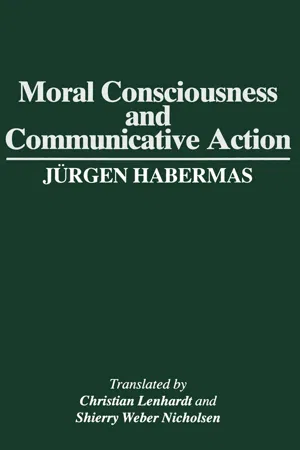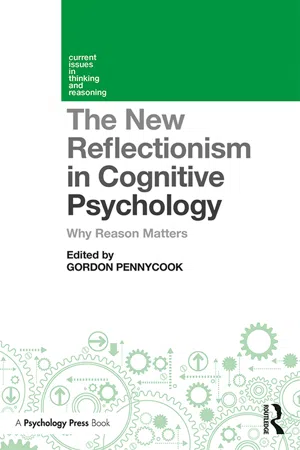Psychology
Kohlberg's Theory of Moral Reasoning
Kohlberg's Theory of Moral Reasoning is a developmental theory that outlines stages of moral development in individuals. It suggests that moral reasoning evolves through six stages, progressing from a focus on self-interest to a consideration of universal ethical principles. Kohlberg's theory emphasizes the role of reasoning and cognitive development in shaping moral decision-making.
Written by Perlego with AI-assistance
Related key terms
10 Key excerpts on "Kohlberg's Theory of Moral Reasoning"
- eBook - ePub
Sports, Games, and Play
Social and Psychological Viewpoints
- Jeffrey H. Goldstein(Author)
- 2012(Publication Date)
- Psychology Press(Publisher)
Kohlberg’s (1981, 1984) work is well known and is only briefly summarized in this chapter. His ground-breaking theory of moral development is rooted in the cognitive developmental approach to psychology most prominently associated with Piaget. Accordingly, the concept of universal stages occupies a central place in Kohlberg’s work. Within the Piagetian framework, stage progression is hypothesized to reflect an interactive process between the innate tendency of the developing child to actively organize information and an environment that demands accommodation to its features.Basic ConceptsFour key concepts can help us understand Kohlberg’s theory of moral development: moral issues, orientations, principles, and stages. Kohlberg believes that certain moral issues or values are universally recognized as important. These issues include the values of life, property, truthfulness, civil liberties, conscience, rules and laws, affiliation, authority, contract, and trust (Kohlberg, 1976). The content of moral thinking is about these moral values. Sometimes, however, one person’s claim on a particular value may come into conflict with those of others. Kohlberg (1969) wrote, “the area of conflicting claims of selves is the area of morality.” Thus, for example, if a player is asked by a coach to violate a rule, the coach’s claim of authority may conflict with the player’s claim to rule obedience.To help clarify what is involved in moral thinking, Kohlberg turns to what he calls the four universal moral orientations (Kohlberg, 1976). A moral orientation is a general approach for dealing with moral conflicts. Each moral orientation focuses on a critical element to help decide right and wrong. The first, the normative order orientation, focuses on prescribed rules and roles; decision making is guided by a consideration of rules. The consequence orientation focuses on the impact of various actions on the welfare of others and/or the self; decision making is guided by beliefs about the outcome of various behavioral options. The justice orientation focuses on the relations of liberty, equality, reciprocity, and contract between people. In decision making, this orientation is characterized by a concern for impartiality and fairness. Finally, the ideal-self - eBook - ePub
Developmental Psychology
Revisiting the Classic Studies
- Alan M Slater, Paul C Quinn, Alan M Slater, Paul C Quinn(Authors)
- 2020(Publication Date)
- SAGE Publications Ltd(Publisher)
Kohlberg’s typology included six stages grouped into three levels. Individuals begin at the lowest level and later move to higher levels, but only rarely reach the highest levels. Kohlberg referred to the first level as the Pre-Moral Level, with judgments characterized by self-interest. Within this level, a Stage 1 orientation focuses on avoiding punishment and demonstrating obedience for its own sake, and a Stage 2 orientation focuses on what Kohlberg called “naive instrumental hedonism” which is often characterized as “you scratch my back and I’ll scratch yours.” Kohlberg referred to the second level as the Morality of Conventional Role-Conformity, in which judgments are characterized by an emphasis on social relationships and an appreciation of norms and conventions. Within this level, a Stage 3 orientation focuses on maintaining positive relations with others by following expected societal standards for being good, and a Stage 4 orientation focuses on respecting laws in order to maintain social order. Kohlberg referred to the third level as Morality of Self-Accepted Moral Principles, with judgments characterized by a focus on the internally held moral principles. Within this level, a Stage 5 orientation focuses on coordinating the interest of the group with important universal values such as the need to preserve life, and Stage 6 focuses on acting according to conscience in relation to basic principles of fairness such as equality and human rights.Kohlberg found evidence of age-related change associated with the stages. The prevalence of reasoning associated with the first two stages decreased with age, reasoning associated with the second two stages increased with age and reached a plateau at age 13, and reasoning associated with the final two stages increased over time. He argued that it was necessary for individuals to pass through the stages in sequence, and that the pattern of intercorrelations he observed among the different types of moral judgments supported the notion that the higher levels of moral reasoning replace the lower levels as children develop.Kohlberg discussed points of agreement and disagreement with Piaget. He agreed with Piaget that moral development involves the construction of belief systems within the context of social interactions, rather than a passive process of internalizing external rules. He also described the relations between his stages and some of Piaget’s. For example, Kohlberg viewed his Stage 1 as closely corresponding to Piaget’s heteronomous stage, with each describing an emphasis on outcomes versus intentions and each defining what is morally right in terms of obedience to authority. Piaget viewed this account of morality as reflecting the level of respect children have for authority figures, and argued that it leads children to believe it is appropriate for adults to define what is right and wrong. In contrast, Kohlberg argued that children’s reasoning at this stage is grounded in a hedonistic desire to avoid punishment rather than respect for adult authority. Kohlberg also drew parallels between his Stage 5 and what Inhelder and Piaget (1958) described as formal operations, the most mature level in his account of cognitive development, in which reasoning is characterized by the capacity to engage in abstract thinking and deductive reasoning. Kohlberg believed that the cognitive advances associated with this stage allow children to engage in the type of hypothetical and logical reasoning that is necessary to contemplate alternative systems of social norms and think through the implications of abstract moral principles such as humanitarianism and democracy. - eBook - ePub
Moral Development
Theory and Applications
- Elizabeth C. Vozzola, Amie K. Senland(Authors)
- 2022(Publication Date)
- Routledge(Publisher)
Beyond its historical significance, Kohlberg's dissertation contains many ideas relevant to moral development today. The early document foreshadows his future interest in the promise of moral education. “Yet the understanding of the moral educator is not that of the permissive therapist; it is an understanding which leads to higher demands as well as to forgiveness” (Puka, 1994, p. 367).Kohlberg's Structural Stage Theory of Moral Development
Building on Piaget's work, Kohlberg posited a developmental paradigm of invariant, sequential, deep-structural stages of moral judgment. Kohlberg's work, however, extended Piaget's two phases to six, later modified to five, invariant stages of moral development across the lifespan. Each of his stages represented an increasingly adequate logical structure for reasoning about rules, roles, and institutions. A key concept of the theory holds that stage progression entails the development of logically richer and ever-more inclusive reciprocity that can be used to solve moral problems or dilemmas. At the pinnacle of moral reasoning, postconventional judgments, reciprocity involves the balancing of the rights and responsibilities of all concerned parties and arises from an attitude of mutual respect and commitment to universal principles. Justice represents the central notion in Kohlberg's theory, and each of his successive stages embodies justice for a larger body of people (Colby & Kohlberg, 1987 ; Kohlberg, 1976 , 1981 , 1984; Lickona, 1976).Kohlberg revised his six stages several times over the years and thus readers of primary and secondary literature in moral development will note differences in terminology and definitions in tables summarizing the stages. The brief tables found in various texts and articles have sometimes resulted in confusion and “inventive interpretations” (Rest & Narvaez, 1994 - eBook - ePub
Postconventional Moral Thinking
A Neo-kohlbergian Approach
- James R. Rest, Darcia Narv ez, Stephen J. Thoma, Muriel J. Bebeau(Authors)
- 1999(Publication Date)
- Psychology Press(Publisher)
As mentioned earlier, Kohlberg’s six-stage theory addresses only one process in the psychology of morality (namely, moral judgment), not the entire ensemble of processes. Kohlberg discussed various component processes in the psychology of morality, dividing up morality mainly into judgments about justice, individual responsibility, and outward behavior (Kohlberg & Candee, 1984). Some critics have said that Kohlberg’s theory (dealing with moral judgment) is too cerebral, that it misses the “heart” of morality (e.g., Gilligan, 1982). But the special function of the construct of moral judgment is to provide conceptual guidance for action choice in situations in which moral claims conflict. In contrast, there are other constructs that deal with the agony of divided loyalties, with the amount of compassion and emotional energy involved in moral conflict, and with the acceptance of responsibility and the motivation (or lack of it) to do the right thing (“right” as defined by moral judgment). Later, we present our conception of what is involved in the psychology of morality, moral judgment being just one of the processes. Briefly, we conceptualize the entire domain of moral psychology to include at least four major internal component processes that lead to moral behavior: moral sensitivity, moral judgment, moral motivation, and moral character (Bebeau, 1994b; Bebeau, Rest, & Narvaez, in press; Narvaez & Rest, 1995; Rest, 1983; Thoma, 1994a).Need for Intermediate Constructs
There are different levels of abstraction in describing moral cognition. Kohlbergian stages are gross, highly abstract markers of life span development that deal with the overall justification of a moral system. Kohlberg’s six stages are like describing general epochs in history (e.g.. Stone Age, Bronze Age, Middle Ages, Industrial Age, Information Age), not finegrained descriptions (e.g., month-day-year). The limits of the highly abstract nature of Kohlbergian stages were stated in a particularly succinct way by Kenneth Strike (1982) in regard to the moral decision making of teachers:Even if these views [Kohlberg’s theory] are essentially correct, they do not provide an adequate basis for teaching teachers about ethics. The essential problem is that the emphasis is on the development of abstract principles of moral reasoning instead of instruction in the more concrete ethical principles that should inform the daily activities of the practicing teacher. It is no doubt desirable that teachers acquire sophisticated and abstract principles of moral reasoning…. But a teacher who has a good grasp of abstract moral principles may nevertheless lack an adequate grasp of specific moral concepts, such as due process. (p. 213) - eBook - ePub
Handbook of Moral Behavior and Development
Volume 1: Theory
- William M. Kurtines, Jacob Gewirtz, Jacob L. Lamb(Authors)
- 2014(Publication Date)
- Psychology Press(Publisher)
I have two aims in the following elaboration of my neo-Kohlbergian view. First, I elucidate through an example the “constructive” (as opposed to “internalization”) aspects of moral development in cognitive-developmental theory, and thereby identify an internal contradiction in Kohlberg’s writings. Second, I justify my designation of stages 3 and 4 as mature on the basis of a critique of the referents of moral judgment maturity in traditional Kohlbergian theory, namely, his “postconventional” or “principled” stages (5 and 6). Refinement of the referents for Kohlberg’s general theoretical contentions is a critical prerequisite to progress toward an integration of Kohlberg’s and Hoffman’s theories of morality.Difficulties in Kohlberg’s interpretation of developmental processes and maturity are best explicated in terms of the three levels by which he classifies his six stages. Kohlberg would seem to agree that moral maturity inheres in the discernment of underlying meaning. In Kohlberg’s theory, however, “underlying meaning” has as its referent a “principled” orientation to interpersonal relationships and society. Drawing upon certain early 20th-century writings (Dewey & Tufts, 1908; McDougall, 1908), Kohlberg (1984) characterized his first two stages as the understanding and acceptance of social conventions (preconventional level); stages 3 and 4 as “conforming to and upholding the rules and expectations of conventions of society or authority just because they are society’s rules, expectations, or conventions” (p. 172; conventional level); and stages 5 and 6 as “based on formulating and accepting the general moral principles that underlie these rules” (p. 173; postconventional level; emphasis added).The postconventional level is considered “internal,” however, not only because of the discernment of underlying moral principles, but also because the moral principles are “self-chosen” (p. 173), and independent of social approval or disapproval (p. 91). - eBook - ePub
- Lee Wilkins, Clifford G. Christians, Lee Wilkins, Clifford G. Christians(Authors)
- 2020(Publication Date)
- Routledge(Publisher)
Personal Interest schema, is defined by rules that are delivered by authority and are inviolable; breaking rules results in punishment, and adherence to rules is either to avoid punishment or gain rewards. In this stage, people are concerned with their own welfare. Acts that provide satisfaction to the self and others are “right,” but others are considered only when their needs are in line with one’s own. This level of moral development is defined by simple, self-interested obedience to the rules—following the rules primarily when it is in one’s own interest to do so. People who use the personal interest schema make moral decisions based on reasons that emphasize self-interest and punishment for wrongdoing. In the latter half of this stage or schema, reciprocity and fairness begin to emerge in a self-serving way, for example, children would agree to give others a birthday present because they believe that others will reciprocate on their birthday.The second stage of Conventional reasoning, now renamed the Maintaining Norms schema, is where rules begin to be respected for their own sake and are eventually seen as serving society. Rules are necessary for maintaining social order and can be changed if all agree. This category is defined by conformity to the expectations of society. Helping others and gaining their approval drive an individual’s actions. At this level, one’s moral reasoning is dominated by “doing one’s duty” and maintaining social order for its own sake. Authority here is vested in the social group(s) to which the individual belongs. The notion of social systems, or doing what is expected to maintain social order, is paramount, as is conformity, or doing what other people expect. Thinking at this stage acknowledges the role of duty. Research suggests that most people operate at this level of moral development most of the time (Kohlberg, 1981, 1984).Kohlberg’s highest stage, the Postconventional , is still called Postconventional - Nancy Eisenberg(Author)
- 2014(Publication Date)
- Psychology Press(Publisher)
As was mentioned previously, the most detailed and influential model of moral judgment is that of Kohlberg and his colleagues (e.g., Colby, Kohlberg, & Kauffman, in press; Kohlberg, 1969, 1976). Kohlberg has outlined a number of specific assertions regarding the nature of the development of moral judgment, and the characteristics of developmental stages. Because of the familiarity of Kohlberg’s model to all researchers and theorists in the area of moral development and the role it has played in this domain of study, our thinking will be compared with that of Kohlberg, Colby, and their colleagues. As will become clear, there are both important similarities and differences between Kohlberg’s and our assumptions.To conduct the proposed comparison, it is necessary to briefly outline both Kohlberg’s theory and his coding system. The latter is important because the manner in which moral reasoning is measured has a direct effect on the degree to which some theoretical assertions are supported. Moreover, differences in the ways in which Kohlberg and we have assessed moral reasoning have resulted in somewhat disparate views concerning the development of moral reasoning.KOHLBERG’S CONCEPTUAL MODEL
Assertions
In Kohlberg and his colleagues’ view, moral judgments are interpreted as the individual’s perceptions of moral reality. Thus, individuals’ thinking about moral questions and their interpretation of moral issues are perceived as important determinants of moral conduct (Colby et al., in press).An important distinction in Kohlberg’s theory is between content of moral judgment (specific moral beliefs or opinions) and structure of reasoning (the general organizing principles or patterns of thought). Kohlberg has focused primarily on structure because it is the structure, not the content, that is believed to exhibit developmental regularity and generalizability within and across individuals. Moreover, the meaning of an individual’s moral beliefs is viewed as dependent on an understanding of the individual’s general moral view or conceptual framework (Colby et al., in press). According to this model, people construct meaning as a result of the process of dealing with various situations; however, the individual’s meaning structure is limited by his or her current developmental level of structure, as well as the individual’s prior history.Kohlberg has differentiated between what he labels as hard structural and soft structural stage models. As discussed in Chapter 2 , the criteria for hard stages (borrowed from Piaget) are as follows:1. Stages imply a distinction of qualitative difference in structures (modes of thinking) that still serve the same basic function (for example, intelligence) at various points in development.- eBook - ePub
Theories of Development
Concepts and Applications
- William Crain(Author)
- 2015(Publication Date)
- Routledge(Publisher)
Martin Luther King expressed his personal view this way: “I am convinced that the universe is under the control of a loving purpose, and that in the struggle for righteousness man has cosmic companionship” (1963, p. 153). No matter what King faced, this “cosmic companionship” kept him going.Kohlberg based his ideas about stage 7 on the lives of moral leaders as well as James Fowler’s research on the development of faith in children and adults. On the basis of very limited data, Kohlberg speculated that stage 7 follows stage 6 of moral reasoning. It comes after stage 6 as an answer to the question of why one should act morally when it feels pointless to do so. If it emerges this late, stage 7 is extremely rare (Kohlberg & Power, 1981). One of Kohlberg’s former coworkers, John Gibbs (2003), suggests that stage 7 thinking often occurs earlier and is even fairly common in adolescence. In any event, I want to emphasize that Kohlberg didn’t consider stage 7 part of his moral stage sequence. Rather, he thought of it as a type of consciousness through which some individuals gain moral strength (Kohlberg & Power, 1981).THEORETICAL ISSUES
How Development Occurs
Kohlberg, it is important to remember, was a close follower of Piaget. Accordingly, Kohlberg’s theoretical positions, including that on developmental change, reflected those of his mentor. Kohlberg (e.g., 1968; 1981, chap. 3) said his stages are not the product of maturation—that is, the stage structures and sequences do not simply unfold according to a genetic blueprint.Neither, Kohlberg maintained, are his stages the product of socialization. That is, socializing agents (e.g., parents and teachers) do not directly teach new forms of thinking. Indeed, it is difficult to imagine them systematically teaching each new stage structure in its particular place in the sequence.The stages emerge, instead, from our own thinking about moral problems. Social experiences do promote development, but they do so by stimulating our mental processes. As we get into discussions and debates with others, we find our views questioned and challenged and are therefore motivated to come up with new, more comprehensive positions. The stages reflect these broader viewpoints (Kohlberg et al., 1975). - eBook - ePub
- Jürgen Habermas, Christian Lenhardt, Shierry Weber Nicholsen(Authors)
- 2015(Publication Date)
- Polity(Publisher)
stages of development.If there is no empirical evidence to suggest that we are dealing with more than one postconventional stage, Kohlberg’s description of stage 5 also becomes problematic. We may at least suspect that the ideas of the social contract and the greatest good for the greatest number are confined to traditions that hold sway primarily in England and America and that they represent a particular culturally specific substantive manifestation of principled moral judgment.Taking up certain misgivings of John Gibbs, Thomas McCarthy points out that the relation between a psychologist knowledgeable about moral theory and his experimental subject changes in a way that is methodologically significant as the subject reaches the postconventional level and takes a hypothetical attitude to his social world:The suggestion I should like to advance is that Kohlberg’s account places the higher-stage moral subject, at least in point of competence, at the same reflective or discursive level as the moral psychologist. The subject’s thought is now marked by the decentration, differentiation and reflexivity which are the conditions of entrance into the moral theorist’s sphere of argumentation. Thus the asymmetry between the prereflective and the reflective, between theories-in-action and explication, which underlies the model of reconstruction begins to break down. The subject is now in a position to argue with the theorist about questions of morality.47In the same essay McCarthy draws a useful parallel between sociomoral and cognitive development:Piaget views the underlying functioning of intelligence as unknown to the individual at lower stages of cognition. At superior levels, however, the subject may reflect on previously tacit thought operations and the implicit cognitive achievements of earlier stages, that is, he or she may engage in epistemological reflection. And this places the subject, at least in point of competence, at the same discursive level as the cognitive psychologist. Here, too, asymmetry between the subject’s prereflective know-how and the investigator’s reflective know-that begins to break down. The subject is now in a position to argue with the theorist about the structure and conditions of knowledge.48 - eBook - ePub
The New Reflectionism in Cognitive Psychology
Why Reason Matters
- Gordon Pennycook(Author)
- 2018(Publication Date)
- Routledge(Publisher)
Such trait-level research is obviously important, but more experimental research would strengthen the claim that reasoning plays a causal role in producing moral judgments. Second, research is needed that examines what specific aspects of what we have called “good reasoning” reliably affect moral judgment. For simplicity’s sake, we have treated many different psychological constructs (e.g., cognitive reflectivity, IQ, cognitive style, etc.) as measures of “good reasoning.” But, in the wider literature, these are treated as at least somewhat distinct, which raises interesting questions about which aspects of cognition are related to which aspects of moral judgment. The finding by Pennycook et al. (2014) that cognitive reflectivity, but not cognitive ability, uniquely predicts condemnation of harmless purity offenses is a promising first step in this direction. Our aim in this chapter has been to review the often disparate findings on the role of reasoning in moral judgment and to provide a coherent theoretical account of these findings. We have therefore deliberately not discussed the relationship between reasoning and moral behavior. At the present time, the literature that we have reviewed here and the literature on prosociality and cooperation have had surprisingly little influence on one another, but we see the potential for fruitful cross-pollination between them. In particular, we think that the Social Heuristics Hypothesis (Rand, 2016; Rand et al., 2014) has much to offer the study of moral judgment. On this view, cooperation with others is generally rewarded, and therefore becomes the default, intuitive response, while self-interested non-cooperative behavior relies on deliberate thinking. As we mentioned above (see Note 1), we think that moral judgments can be “intuitive” (i.e., fast and automatic) while still being rooted in reasoning
Index pages curate the most relevant extracts from our library of academic textbooks. They’ve been created using an in-house natural language model (NLM), each adding context and meaning to key research topics.
